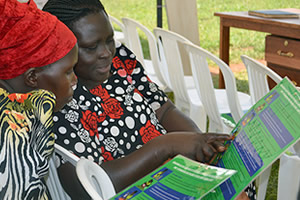Why I care about M&mi

I am a passionate person, for me to get involved means that I care, I am invested in what happens. And yet numbers, data can seem so … NOT passionate. They can seem dry, static, abstract scribbles on a piece of paper or on a computer screen. I like life, people, what’s happening in the outside world. Numbers and data seem so removed from emotions, they tend to appeal to the brain and not the heart. For many years, even though I had taken many math courses through school and then statistics classes for my graduate studies, my day-to-day existence was lived largely apart from the world of data and monitoring and evaluating things happening in the world. I don’t remember the exact moment when it hit me but I started to “hear” the language of M&mi. Rather than abstract numbers, meaningless information coming across my desk – all of a sudden the numbers started talking to me, telling me a story about the world, about people and things that I cared about.
I wasn’t fluent in this new, foreign language at first. My understanding would come and go. Sometimes the numbers would just become abstract symbols again, floating past my eyes, while something else caught my attention. But increasingly I not only listened for what the numbers were saying, I started talking back to them, asking them other questions, trying to figure out more about what they were trying to tell me. I started demanding of myself that I understand what this language was saying – what was happening, who was involved, was something positive happening or was it something that needed action.
As I started to talk this language and have these types of conversations with others, I realized that the “M&E language” was very misunderstood. Most people were either ignorant of its existence or, if they did know about it, they actively avoided the language, thinking it too complicated or even irrelevant. I started thinking about why people should care about this language. Information in a vacuum is not very interesting or useful to people but now I saw that the data themselves, the information they represented, could and needed to be used in bringing about positive change. The data needed to be heard and they needed to be understood (interpreted, put into context) but, most importantly, they needed to be put into the hands of people who make decisions.
All of us, at whatever level of responsibility, whether professionally or personally, make decisions. We make decisions for many reasons and in many ways. Our decisions may not always be “logical”, rational based on objective data and sometimes one can decide that a “non-rational” decision is needed. Sin embargo, the starting point for decision making should ALWAYS be from the point of having good, quality data (oportunos, complete, preciso, reliable, valid) in front of us. Good data are objective, they do not advocate for one approach or another, they inform the decision maker as to what the current situation is so that any decision taken, is taken in knowledge of WHAT IS, not what we THINK IS or what we might WANT IS to be.
When decisions are made WITHOUT good quality data being available, the decision maker does not have accurate information about what the situation currently is and this makes it difficult, often impossible, to make a decision and have it be the right one to address the situation. The decision maker is operating blindly.
This is why I care about having data for monitoring what is happening, so that I know what is happening and can make decisions about activities, people, resources that will continue to move things in the right direction. If things are not moving in the right direction, I have the information that will help me make corrections, modifications to get back on track. The “Evaluation” in M&E is an extension of this – not just are we moving in the right direction but have we achieved the goals, objetivos, targets we have set. No sense in continuing a strategy or approach that did not yield the results we set out to achieve.
Así que, I continue to study the M&E language, trying to learn its subtleties, alert to what it is trying to tell me. And I try to encourage all those I work with to learn this language, appreciate what it can teach us and then use what we have learned to help others. METRO&E is and must be a universal language and it is up to us to use that language and the information we get from it to make things better in our communities, countries and beyond.
Join me in community of practice Creación de entornos propicios para el seguimiento y la evaluación (CEEME). Let’s master language of M&E together!






Scott
Powerful write up, i am thinking, sí, I am a educational technologist, simply put helping learners use technology- I use Moodle with other web 2.0 tools including social media- and yes i think M &mi, so that we can determine and identify when guys are not gaining their learning outcomes and the type of interventions needed.
Thanks Norbert. There is obviously much that can be done and needs to be done in terms of effectively leveraging technology both for learning/education and for subsequent behavior change. At the end of the day, it’s all about people. Individuals and groups are the determinants, the agents of performance. Once they have the knowledge and the resources, what’s left is the actual desire to do well. That cannot be forced or mandated but it can, and must be, encouraged and supported. That role is up to each and every one of us. Thanks again for you interest in the continuing discussion!